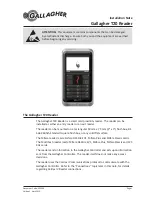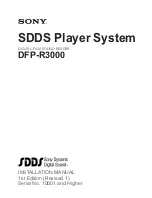
KPCI-3101 — KPCI-3104 Series User’s Manual
illustrates the same example using internally-retriggered scan mode. The multiscan
count is 2, indicating that the channel-gain list will be scanned twice per trigger or retrigger. In
this example, pre-trigger analog input data is acquired on each clock pulse of the A/D sample
clock for two scans; then, the board waits for the internal retrigger event. When the internal
retrigger occurs, the board begins acquiring pre-trigger data until the post-trigger event occurs.
Then, the board finishes scanning the channel-gain list the specified number of times, acquiring
the data as post-trigger samples. On all subsequent internal retriggers, post-trigger data is
acquired.
Figure 2-7
Continuous about-trigger mode with triggered scan
Data format
KPCI-3101–4 Series boards use offset binary data encoding to represent signals.
In DriverLINX software, the analog input value is returned as a code or voltage depending on
user input. DriverLINX provides single-value and buffer methods to convert between voltages
and analog codes. The single-value functions are Volts2Code and Code2Volts. Refer to
DriverLINX manuals provided with DriverLINX.
Data transfer
The board packs two input samples (an even and an odd sample) into each transfer to the host
computer. Samples corresponding to entries 0, 2, 4, and so on, in the channel-gain list are con-
sidered even samples; samples corresponding to entries 1, 3, 5, and so on, in the channel-gain
list are considered odd samples.
Using flags internally, the board determines whether the acquired samples are pre-trigger or
post-trigger samples. These flags are not transferred to the host computer. The host computer can
read the register on the board to determine where the post-trigger data starts. Note that the host
computer cannot read data directly from the board; the data must be transferred to the host
computer.
Using PCI bus mastering, the board transfers the analog input data to a 256KB circular buffer in
the host computer; this buffer is dedicated to the hardware. Therefore, unlike ISA and EISA
boards, the KPCI-3101–4 Series board requires no DMA resources. The board treats each buffer
as two consecutive 128KB blocks of memory.
Pre-trigger event occurs;
pre-trigger data is
acquired for two scans of
the CGL.
Chan 0
Chan 1
Chan 0
Chan 1
A/D
Sample
Clock
Re-trigger event occurs;
pre-trigger data is
acquired until post-trigger
occurs.
Chan 0
Chan 1
Chan 0
Chan 1
Chan 0
Chan 1
Post-trigger event occurs;
post-trigger data is
acquired until the end of
the number of scans.
Re-trigger event
occurs;
post-trigger data is
acquired for two
scans of the CGL.
Chan 0
Ch1
Содержание KPCI-3101 Series
Страница 1: ...User s Manual KPCI 3101 3102 3103 3104 Series PCI Bus Data Acquisition Boards 98150 Rev A 10 99...
Страница 10: ...iv...
Страница 15: ...1 Overview...
Страница 21: ...2 Principles of Operation...
Страница 53: ...3 Installation and Configuration...
Страница 78: ...3 26 Installation and Configuration KPCI 3101 KPCI 3104 Series User s Manual...
Страница 79: ...4 Testing the Board...
Страница 82: ...4 4 Testing the Board KPCI 3101 KPCI 3104 Series User s Manual...
Страница 83: ...5 Calibration...
Страница 86: ...5 4 Calibration KPCI 3101 KPCI 3104 Series User s Manual...
Страница 87: ...6 Troubleshooting...
Страница 94: ...6 8 Troubleshooting KPCI 3101 KPCI 3104 Series User s Manual...
Страница 95: ...A Specifications...
Страница 107: ...B Connector Pin Assignments...
Страница 111: ...C Systematic Problem Isolation...
Страница 145: ...This page intentionally left blank...
Страница 146: ...Keithley Instruments Inc 28775 Aurora Road Cleveland Ohio 44139 Printed in the U S A...
















































